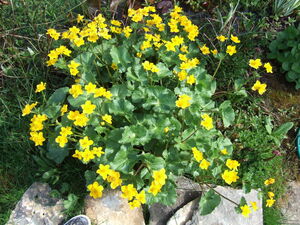אין תקציר עריכה |
מ (Daniel ventura העביר את הדף Caltha palustris לציפורני חתול ביצות צהובות) |
גרסה מ־13:43, 20 ביוני 2014

Caltha palustris צילם:Jasper33

זרעים ופרי צילם: Didier Descouens
Caltha palustris בתרגום: "ציפורני חתול ביצות צהובות" - מכונה גם "גביע המלך" kingcup או "צפורני חתול הביצה" marsh marigold הוא צמח רב-שנתי ממשפחת הנוריתיים, הרגיל לצמוח בקרקע רטובה, כמו בביצה, בחצי כדור הארץ הצפוני.
הוא כנראה אחד מהצמחים העתיקים ביותר, ששרד מעידן הקרח וצמח לאחר הנסיגה האחרונה של הקרח, בנוף מוצף מים. מתקיים ביער לא-צפוף, שחודרים אליו קרני השמש אך יש בו מעט צל. באו"ם
תיאור הצמח
צמח רב שנתי, עם קנה שורש קצר ממנו חלק מחבילה של שורשים בשרניים. גזע עולה, פיסטולה, בשרני, נטול שיער. קיצוני משאיר reniform עם רדיד (6-8 5-7 סנטימטר) ופטוטרת 5-20 סנטימטר; אלה cauline דומה, אך קטן יותר בהדרגה וsubsessili. פרחים: 2-7 עלי כותרת בזהב צהוב, אבקנים צהובים רבים, עלי גביע נעדר. פירות: זקיק המכיל כמה זרעים.
גובה הצמח מגיע עד 80 סנטימטר, העלים מעוגלים, בצורת כליה, במימדים של 3-20 סנטימטר עם מרווח משונן בצורה בוטה ומרקם סמיך, דונגי. הגבעולים הם חלולים.
הפרחים הם בגודל 2-5 סנטימטר בצבע צהוב,, עם 4-9 (בעיקר 5) עלי גביע כמו עלה כותרת ואבקנים רבים צהובים; הם מופיעים בתחילת האביב עד סוף הקיץ. הפרחים הם ביקרו מגוון גדול של חרקים לאבקה והצוף המופרש משקעים קטנים, אחד בכל צד של כל carpel.
Carpels טופס לתוך זקיקים דמויי שק ירוקים כדי 1 סנטימטר ארוך, כל פתיחה לשחרר כמה זרעים.
palustris Caltha הוא מיני צורות רבים, מראה וריאציה רציפה ובלתי תלויה בתכונות רבות. טפסים בבריטניה עשויים להיות מחולקים לשני תת מין: subsp palustris Caltha. subsp palustris palustris, וCaltha. קטין.
לפעמים זה נחשב עשב בקרקעות גינה כמו חימר, שבו כל פיסת השורש שלה תשרוד ולהתפשט. בקרקעות ניקוז נטולות חמות, זה פשוט מת משם.
כמו במקרה עם רבים מבני המשפחה , כל חלקי הצמח רעילים ויכולים להיות מטרד. פריחות בעור ודלקת עור כבר דיווחו מטיפול מוגזם של הצמח.
Other names and etymology
Caltha palustris pollination by a syrphid fly Sphegina montana.
In the UK, Caltha palustris is known by a variety of common names, varying by geographical region. These include marsh marigold and kingcup (the two most frequently used common names), mayflower, May blobs, mollyblobs, pollyblobs, horse blob, water blobs, water bubbles, gollins. Balfae (in Caithness) and the publican. The common name of marigold refers to its use in medieval churches at Easter as a tribute to the Virgin Mary, as in Mary gold.
The specific name palustris, Latin for "of the marsh", indicates its common habitat.
Richard Mabey, in Flora Britannica, describes Caltha palustris thus:
"Marsh-marigolds are in decline as agricultural land continues to be drained, but they are still the most three-dimensional of plants, their fleshy leaves and shiny petals impervious to wind and snow, and standing in sharp relief against the tousled brown of frostbitten grasses. Most of the plant's surviving local names - water-blobs, molly-blobs, water-bubbles - reflect this solidity, especially the splendid, rotund 'the publican' from Lancashire."
Caltha palustris flowers
In North America Caltha palustris is sometimes known as cowslip. However, cowslip more often refers to Primula veris, the original plant to go by that name.[1][2][3] Both are herbaceous plants with yellow flowers, but Primula veris is much smaller.
Caltha palustris is a plant commonly mentioned in literature, including Shakespeare:
- Winking Marybuds begin
- To open their golden eyes (Cymbeline, ii. 3).
Kingcup Cottage by Racey Helps is a children's book which features the plant.
In Latvia Caltha palustris is also known as Gundega which is also used as a girls name which symbolizes fire. The word Gundega is made from 2 words - uguns (fire) and dega (burned). This refers to the burning reaction that some people experience from contact with Caltha sap.
Subspecies, varieties and cultivars
Caltha palustris var. himalensis in Kullu District of Himachal Pradesh, India.
Caltha palustris var. alba
The 2006-2007 edition of the Royal Horticultural Society Plant Finder, a British publication which lists over 70,000 plants available in nurseries in the United Kingdom, lists the following:
- Caltha palustris[4]
- Caltha palustris var. alba
- Caltha palustris var. barthei
- Caltha palustris var. himalensis
- Caltha palustris var. palustris
- Caltha palustris var. palustris 'Plena' (double flowered)
- Caltha palustris subsp. polypetala
- Caltha palustris var. radicans
- Caltha palustris 'Flore Pleno' (a double-flowered cultivar, awarded the RHS's Award of Garden Merit)
- Caltha palustris 'Semiplena' (double flowered)
- Caltha palustris Trotter's form
- Caltha palustris 'Yellow Giant'
- Caltha palustris 'Marilyn'
- Caltha palustris 'Multiplex' (double flowered)
Environmental conservation
It is a component of Purple moor grass and rush pastures - a type of Biodiversity Action Plan habitat in the UK. It occurs on poorly drained neutral and acidic soils of the lowlands and upland fringe.
Notes
- ↑ "cowslip". Webster's 1828 Dictionary. http://1828.mshaffer.com/d/word/cowslip.
- ↑ "cowslip". The American Heritage Dictionary of the English Language, Fourth Edition. 2000. http://www.bartleby.com/61/7/C0710700.html.
- ↑ "cowslip". Merriam-Webster Online Dictionary. http://www.merriam-webster.com/dictionary/cowslip.
- ↑ "RHS Plant Selector - Caltha palustris". http://apps.rhs.org.uk/plantselector/plant?plantid=295. Retrieved 20 June 2013.
References
- Clapham, A. R., Tutin, T. G., and Warburg, E. F., 1962, Flora of the British Isles Cambridge University Press
- Lord, Tony (ed), 2006, RHS Plant Finder 2006-2007 London: RHS/Dorling Kindersley ISBN 1-4053-1455-9
- Mabey, Richard, 1997, Flora Britannica London: Chatto and Windus
- Rose, Francis, 2006, The Wild Flower Key (edition revised and expanded by Clare O'Reilly) London: Frederick Warne ISBN 0-7232-5175-4
- Flora of China: Caltha palustris
- Flora Europaea: Caltha palustris
- Flora of North America: Caltha palustris
- Germplasm Resources Information Network: Caltha palustris
- שגיאת תסריט: היחידה "citation/CS1" אינה קיימת.
- תבנית:Cite Americana
External links
תבנית:Commons category